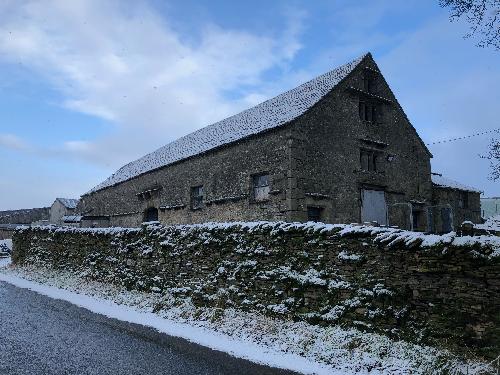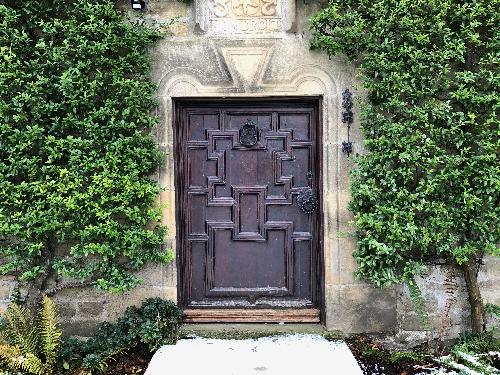| JOURNAL 2021 |
| North Craven Heritage Trust |
Introduction
Bank Barn is an impressive building both in terms of its sheer size as well as the incorporation of unusual features such as the mullion windows in the gable wall. It is situated (SD 77 63766112) on the Lawkland Hall estate, being 100m north of the house. The gable end faces the front of the house and it is assumed that it was architecturally embellished for this reason. In 2014 the barn was surveyed as part of Master of Studies in Building History course at Cambridge University. The resulting report has been deposited with the Yorkshire Buildings Study Group. The survey showed that the barn had been modified several times and that material from Lawkland Hall had been incorporated in the building when that house was itself altered. It was not possible to establish the date when the barn was originally built, though this may have coincided with the alterations to the Hall undertaken by Arthur Ingleby in 1679. Bank Barn contains a date stone of 1763 which may commemorate the extension built by John Stephen Ingleby.
On the interior of the arch to the taller, east wagon entrance a carving of a small Greek cross in the stonework has long been an intriguing feature. It is not on the keystone of the arch where it might be expected. Perhaps it is a mason’s mark but is seems too elaborate for that. (Examples of local masons’ marks can be seen in the Journal of 2006 page 2) The other feature noted was a series of three inverted triangles on the corbels, above the lower wagon entrance. It is possible that these are Christian symbols representing the Trinity. Again the date of these features is uncertain and they may have originated in the Hall and later incorporated in the barn during alterations.
The Ingleby family of Lawkland and Austwick Halls
In 1573 John Ingilby (they spelled their surname slightly differently), second son of Sir William of Ripley Castle, purchased property from Peter Yorke, his uncle. This included the manor of Lawkland as well as property in Clapham and Austwick. It has been suggested that the sale was forced on Yorke in order to pay fines imposed on him because he was a recusant [1]. It is suggested that Arthur Ingleby (1632-1701) was responsible for alterations to Lawkland Hall in 1679, as shown by the date stone in the house of that date. There is little doubt that many members of the family were Catholics as several were listed as being fined as recusants from 1590 to 1691 [2]. Further evidence is provided by the presence of a priest hole in the house [3]. Also several of the female members of the family joined religious orders as nuns. For example the youngest sister of John Stephen Ingleby (1716-1789) became the abbess of the English convent at Cambray.At the end of the sixteenth century anyone who refused to attend the Anglican services (ie recusant) was liable to a fine of £3 10 shillings a year to the parish and an additional £260 per year to the crown. After 1586 if the person defaulted on the payment then two thirds of their estate could be seized by the crown. In the seventeenth century the level of fines changed to reflect the annual value of the estate, which ranged from a tenth to a quarter of the total. For example in Lancashire the fines ranged from £2 per year for Thomas Hesketh of Harwood to £100 for Thomas Middleton of Leighton [4]. Thus it was not just the large landowners but also the yeoman farmers who paid the penalties for being recusants.
However, not all Catholics were recusants. This term only applied to those who refused to compromise with the established church. There were also ‘non communicants’ or Catholics who attended Anglican services but did not take communion. Finally there were ‘schismatics’ who took communion whilst still remaining in sympathy or loyal to Catholicism. Thus there were a number of ways of evading the fines whilst remaining a Catholic. In practice it is not always possible to assess, from the records available, whether an individual was a Catholic or otherwise. In the case of Sir Charles Ingleby, of Austwick Hall, there can be little doubt that he was a Catholic.
Charles was born in 1644 and was the seventh child of John Ingleby’s second marriage. As Arthur’s youngest brother it was unlikely that he would inherit Lawkland Hall and its estate so he sought an alternative source of income. Charles was admitted to Brasenose College, Oxford in 1662 and the following year he became a member of Gray’s Inn, being called to the Bar in 1671 [5].
In 1679 Charles Ingleby was one of 18 people arrested and charged with high treason as part of what was known as the Barnbow plot. The group, led by Sir Thomas Gasgoigne of Barnbow, were accused of attempting to murder Charles II [6]. Essentially the evidence rested on the account provided by Robert Bolron, a former employee of Gasgoigne’s, of alleged conversations that had been overheard between members of the group. There were a number of trials in London and York in 1680 and all but one of the defendants were acquitted. Thomas Thwing, who was also accused of being a priest, was found guilty and was publicly executed in York [7].
Charles Ingleby was appointed Serjeant at law (similar to being a Queen’s Counsel) in 1687. The following year James II appointed him as a judge (Baron of the Exchequer) and also knighted him. Sir Charles did not remain in office for long as when James II fled the country his successors, William & Mary, failed to re-appoint him. Ingleby returned to his legal work and his home in Austwick. In 1693 he was fined 40 shillings at the York Assizes for refusing to take the oath of allegiance to William & Mary. It is not clear whether this refusal was on grounds of his faith or possibly because he had already sworn allegiance to James II, who was living in exile. Ingleby was fined again when George I acceded to the throne, by which time James II had died.
In 1717 Sir Charles Ingleby and his son were listed in the Papist register of lands [8] so it is without doubt that they were Catholics at this time. His daughter, Ann, entered a convent in Liege in 1705, with a dowry of £300, and died there in 1764 at the age of 75 years. This register also lists John Ingleby of the city of Durham for his manor of ‘Lawkland cum Feizor’. Two other local Catholics listed for 1723 included Millicent Husband of Bentham and John Husband of Giggleswick: Pam Jordan provides further details of the Husband family in her article in this Journal.
Catholic iconography
Little has been written about Catholic symbolism and its appearance in vernacular architecture. Probably the best known example is that of Rushton Triangular Lodge (1593-7) in Northamptonshire with the many allusions to the number three, representing the Trinity. The building is three sided, has three storeys, with three bays and three gables to each side. Each side measures 33 1/3 feet long and even the chimney is triangular. The surname of the builder, Sir Thomas Tresham, provides a clue to an interest in the number three! He also built a house nearby which was laid out on the plan of a Greek cross (each arm is of equal length). The exterior is covered with religious symbolism with emblems of Christ’s Passion cut into the stone panels. Born a Protestant, Sir Thomas converted to Catholicism and spent long spells in prison for his recusancy.Other examples are more subtle. The porch at Benthall Hall in Shropshire carries the marks of the quincunx, or the five of Christ’s crucifixion wounds. It is thought that this indicated Catholic occupancy of the house to travelling priests and other Catholics. In the same county there is Morville Hall, Upton Cresset and Wilderhope which all contain ornate Elizabethan plaster work with Catholic symbols such as the ‘heart of Jesus’ emblem. Placed in ceiling plasterwork these symbols are not always obvious to the uninitiated.
So what of the features at Bank Barn? Clearly the cross is a Christian symbol but it cannot be entirely ruled out that in this case it was a mason’s mark. And what of the inverted triangles? At the end of the day it is speculation that these represent the Trinity, as does the same symbol which appears above the front door of Lawkland Hall. It may be that these have been re-cycled stonework from the main house, but it is also possible that they indicate that the barn was used as a place of worship [9]. In her article, Pam Jordan refers to Nicholas Skelton using a barn behind his house for religious services. In 1767 58 Catholics were listed as living in the parish of Clapham [10]. It is unlikely that this number could have been accommodated in the chapel of Lawkland Hall so the barn may have provided an alternative venue.
Craven Door Heads
With so few examples of religious symbols being recorded on vernacular buildings it was decided to examine the door heads elsewhere in Craven and locality. The Trust’s website contains records of several hundred door heads. There are three examples of the use of Chi Rho which is a christogram formed from the first two Greek letters of the word Christ (Wigglesworth, 1668; Gisburn, 1673; and Giggleswick, 1669). There are also crosses on two door heads in Long Preston (1695 & 1707) and in Kettlewell there is a cross within an inverted triangle (1590) though this may have been re-cut.. Given time perhaps more triangles will be found among the remaining hundreds of doors. A further line of research would be to try to discover the religious affiliations of the people who owned the houses.
Conclusion
With so little recorded or written about the religious symbolism in vernacular architecture it is difficult to draw firm conclusions. For some the whole topic may be too speculative! However it may encourage us all to look a little more closely at our built environment and research more fully the religious practices in Craven in the 17th & 18th centuries.
References
- Cooper A A, 1988. Yorke Country. Privately printed
- Aveling H, 1963. The Catholic recusants of the West Riding of Yorkshire 1558-1790. Proc. Of the Leeds Philos & Lit Soc. Vol X, part VI
- Ambler L 1913. The old halls and manor houses of Yorkshire with some examples of houses built before the year 1700. London: Batsford.
- Brownbill J, 1908. Lancashire recusants about 1630. Historic Society of Lanc & Cheshire 60: 171-180.
- Foster J, 1891. Alumni Oxoniensis 1500-1714 & Stephen L, 1885 DNB Vol 28
- Bolron R, 1680. The narrative of Robert Bolron concerning the late horrid popish plot and conspiracy for the destruction of His Majesty and the Protestant Religion. London: Simmons
- State Trials 32 Charles II 1680 pp960-1044 & pp1168-1182
- Register of Papists’ lands. West Yorkshire RO, QE28
- McClain L, 2002. Without church, cathedral or shrine: the search for religious space among Catholics in England 1559-1625. Sixteenth Century Journal 33: 381-399
- Garnett E, 2001. Lawkland Hall – a history. Privately printed.

